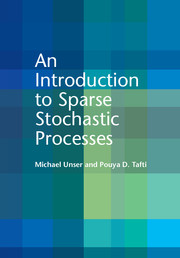Book contents
- Frontmatter
- Dedication
- Contents
- Preface
- Notation
- 1 Introduction
- 2 Roadmap to the book
- 3 Mathematical context and background
- 4 Continuous-domain innovation models
- 5 Operators and their inverses
- 6 Splines and wavelets
- 7 Sparse stochastic processes
- 8 Sparse representations
- 9 Infinite divisibility and transform-domain statistics
- 10 Recovery of sparse signals
- 11 Wavelet-domain methods
- 12 Conclusion
- Appendix A Singular integrals
- Appendix B Positive definiteness
- Appendix C Special functions
- References
- Index
11 - Wavelet-domain methods
Published online by Cambridge University Press: 05 September 2014
- Frontmatter
- Dedication
- Contents
- Preface
- Notation
- 1 Introduction
- 2 Roadmap to the book
- 3 Mathematical context and background
- 4 Continuous-domain innovation models
- 5 Operators and their inverses
- 6 Splines and wavelets
- 7 Sparse stochastic processes
- 8 Sparse representations
- 9 Infinite divisibility and transform-domain statistics
- 10 Recovery of sparse signals
- 11 Wavelet-domain methods
- 12 Conclusion
- Appendix A Singular integrals
- Appendix B Positive definiteness
- Appendix C Special functions
- References
- Index
Summary
A simple and surprisingly effective approach for removing noise in images is to expand the signal in an orthogonal wavelet basis, apply a soft-threshold to the wavelet coefficients, and reconstruct the “denoised” image by inverse wavelet transformation. The classical justification for the algorithm is that i.i.d. noise is spread out uniformly in the wavelet domain while the signal gets concentrated in a few significant coefficients (sparsity property) so that the smaller values can be primarily attributed to noise and easily suppressed.
In this chapter, we take advantage of our statistical framework to revisit such wavelet-based reconstruction methods. Our first objective is to present some alternative dictionary-based techniques for the resolution of general inverse problems based on the same stochastic models as in Chapter 10. Our second goal is to take advantage of the orthogonality of wavelets to get a deeper understanding of the effect of proximal operators while investigating the possibility of optimizing shrinkage/thresholding functions for better performance. Finally, we shall attempt to bridge the gap between operator-based regularization, as discussed in Sections 10.2–10.3, and the imposition of sparsity constraints in the wavelet domain. Fundamentally, this relates to the dichotomy between an analysis point of view of the problem (typically in the form of the minimization of an energy functional with a regularization term) vs. a synthesis point of view, where a signal is represented as a sum of elementary constituents (wavelets.)
The chapter is composed of two main parts. The first is devoted to inverse problems in general.
- Type
- Chapter
- Information
- An Introduction to Sparse Stochastic Processes , pp. 290 - 325Publisher: Cambridge University PressPrint publication year: 2014



